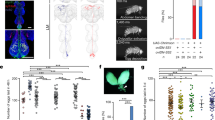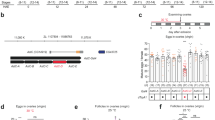Abstract
In the mosquito Aedes aegypti, a blood meal triggers egg development. Early workers used the simple technique of decapitation, or neck ligation, to show that a factor from the head was required for normal egg development1–4. Lea subsequently demonstrated that the source of this factor was the medial neurosecretory cells of the brain5. The hormone from these cells, which he termed the egg development neurosecretory hormone (EDNH), is stored in the corpus cardiacum (CC) and released shortly after a blood meal6. Previous work had demonstrated that the ovary begins to produce ecdysone after a blood meal8. Considerable evidence suggests that the ecdysone, after being converted to 20-hydroxyecdysone, stimulates the synthesis and secretion of vitellogenin by the fat body8–12. The vitellogenin is taken up by the growing oocytes and becomes part of the yolk. Analysis of the amount of 20-hydroxyecdysone present in females after a blood meal showed that significant quantities were first seen 4–6 h after a blood meal8. Vitellogenin synthesis begins at about the same time13. The early decapitation experiments of Gillett demonstrated that the head was necessary for 4–8 h after a blood meal for egg development to proceed normally3. A similar critical time was found for the control of vitellogenin synthesis by the brain hormone7. The coincidence of this timing suggested to us that the ovary was the target of the brain hormone. The experiments reported here were designed to test the hypothesis that the brain hormone released after a blood meal acted on the ovary, causing the synthesis of ecdysone. Our results confirm this.
This is a preview of subscription content, access via your institution
Access options
Subscribe to this journal
Receive 51 print issues and online access
$199.00 per year
only $3.90 per issue
Buy this article
- Purchase on Springer Link
- Instant access to full article PDF
Prices may be subject to local taxes which are calculated during checkout
Similar content being viewed by others
References
Clements, A. N. J. exp. Biol. 33, 211 (1956).
Gillett, J. D. Ann. trop. Med. Parasit. 50, 375 (1956).
Gillett, J. D. Nature 180, 656 (1957).
Larsen, J. R. & Bodenstein, D. J. exp. Zool. 140, 343 (1959).
Lea, A. O. J. Insect Physiol. 13, 419 (1967).
Lea, A. O. Gen. comp. Endocr. Suppl. 3, 602 (1972).
Hagedorn, H. H. & Fallen, A. M. Nature 244, 103 (1973).
Hagedorn, H. H., et al. Proc. natn. Acad. Sci. U.S.A. 72, 3255 (1975).
Hagedorn, H. H. Am. Zool. 14, 1207 (1974).
Fallon, A. M., Hagedorn, H. H., Wyatt, G. R. & Laufer, H. J. Insect Physiol. 20, 1815 (1974).
Bohm, M. K., Behan, M. & Hagedorn, H. H. Physiol. Ent. 3, 17 (1978).
Hagedorn, H. H., Kunkel, J. G. & Wheelock, G. J. Insect Physiol. 24, 481 (1978).
Hagedorn, H. H., Fallon, A. M. & Laufer, H. Devl Biol. 31, 285 (1973).
Borst, D. W. & O'Connor, J. D. Steroids 24, 637 (1974).
Charlet, M., Goltzene, F. & Hoffmann, J. A. J. Insect Physiol. 25, 461 (1979).
Chang, Y. H. & Judson, C. L. Comp. Biochem. Physiol. 57c, 147 (1977).
Hanaoka, K. & Hagedorn, H. H. in Progress in Ecdysone Research (ed. Hoffmann, J. A.) (Eisevier, Amsterdam, in the press).
Hagedorn, H. H. et al. J. Insect Physiol. 23, 203 (1977).
Winogradska, O. N. Z. ParasitKde. 8, 697 (1936).
Author information
Authors and Affiliations
Rights and permissions
About this article
Cite this article
Hagedorn, H., Shapiro, J. & Hanaoka, K. Ovarian ecdysone secretion is controlled by a brain hormone in an adult mosquito. Nature 282, 92–94 (1979). https://doi.org/10.1038/282092a0
Received:
Accepted:
Issue Date:
DOI: https://doi.org/10.1038/282092a0
Comments
By submitting a comment you agree to abide by our Terms and Community Guidelines. If you find something abusive or that does not comply with our terms or guidelines please flag it as inappropriate.



